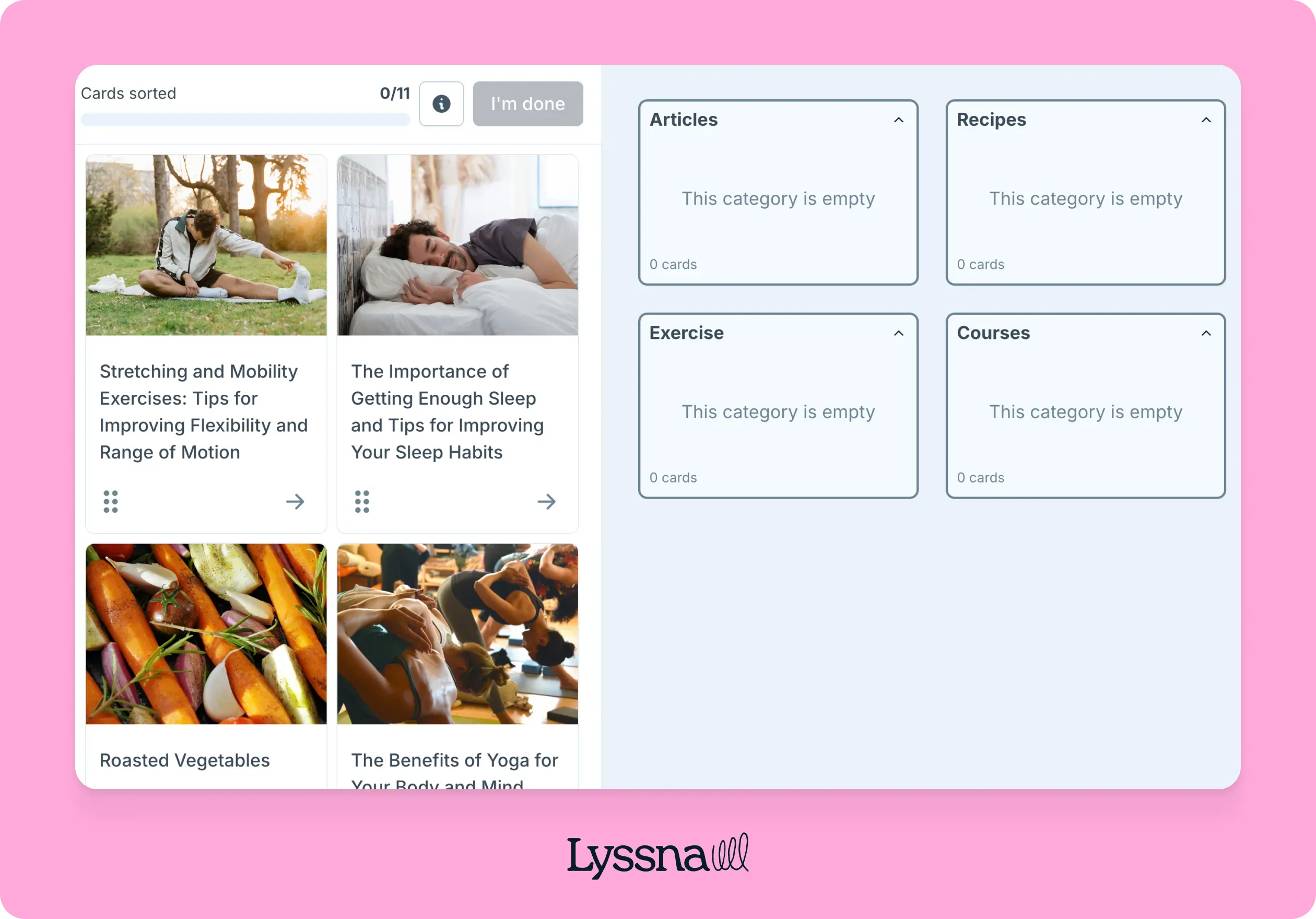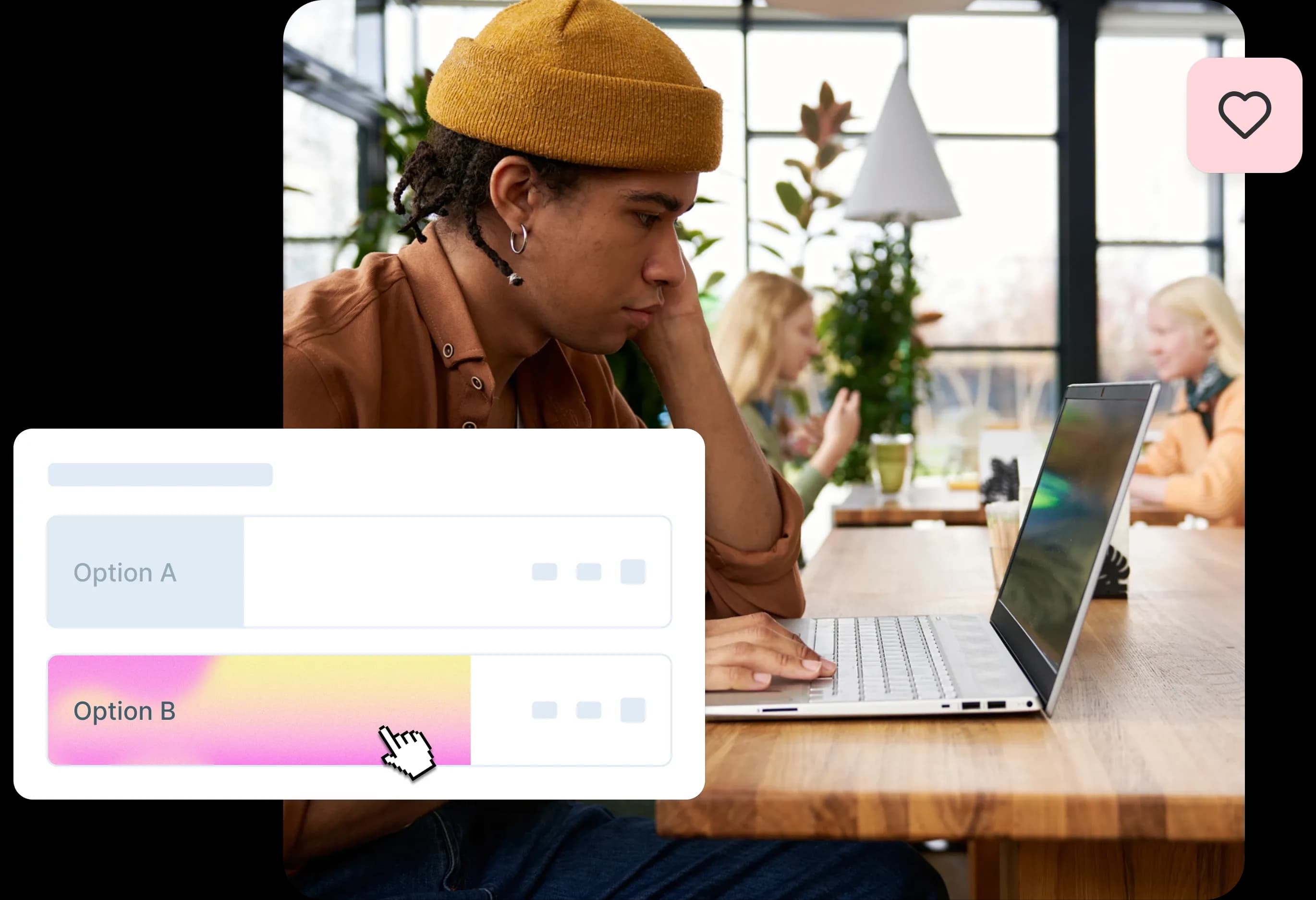07 Aug 2025
|14 min
Randomization in research
Discover what randomization in research is, why it's essential for reducing bias, and how it's used in clinical trials, surveys, and experiments to ensure valid results.

Picture this: you've just finished analyzing the results from your latest user survey, and everything points to a clear preference for Design A. But then you realize that Design A was always shown first to participants. Did users genuinely prefer it, or were they influenced by seeing it before the alternatives?
This scenario highlights one of the biggest challenges in user research – even with the best intentions, bias can sneak into our studies and skew our results. The order you present questions, the sequence of tasks, or how you show design concepts can all influence participant responses in ways you might not expect.
The good news? There's a simple yet powerful way to improve the reliability of your research: randomization. By introducing an element of chance into your studies, you can reduce bias and generate genuine user insights that reflect how people think and behave.

What is randomization in user research?
Randomization in user research is the process of randomly assigning participants, questions, content, or other elements to eliminate systematic bias and make sure that your findings represent real user behavior and preferences. Rather than following a predetermined order or pattern, randomization introduces an element of chance that helps neutralize factors that could skew your results.
Think of it as leveling the playing field for your research. When you randomize elements in your study, you're making sure that any external factors that might influence responses are distributed equally across all participants, giving you cleaner, more reliable data to work with.
In user research, randomization can be applied to various aspects of your study, from the order survey questions are presented to the sequence of tasks in a usability test, or even the random assignment of participants to different test conditions.
Eliminate research bias
Stop second-guessing your research results. Try Lyssna's built-in randomization features free and get reliable user insights.
How bias affects user research
Bias is everywhere in research, often hiding in places we don't expect. Even small, seemingly insignificant factors can dramatically impact how users respond to your questions or interact with your designs.
Order effects
When participants see questions or tasks in the same sequence, their responses to later items can be influenced by what they've already seen. For example, if you always ask about pricing before asking about features, participants might frame their feature preferences based on the pricing information they just processed.
Consider this example: A team testing two design concepts always showed Design A first. They found that 70% of participants preferred Design B, but when they randomized the order, preferences were split almost evenly. The original results were influenced by order effects – participants were unconsciously comparing the second design to the first rather than evaluating each on its own merits.
Question sequence bias
This can create patterns in responses that don't reflect genuine user preferences. Participants might become fatigued as they progress through a long survey, leading to less thoughtful responses to questions that appear later. Alternatively, they might develop response patterns or be primed by earlier questions to answer subsequent ones in a particular way.
Selection bias
In participant recruitment, this can also skew your results. If you always recruit from the same sources or at the same times, you might consistently miss certain user segments, creating blind spots in your research.
Here's how randomization tackles each type of bias we've discussed:
Type of bias | What it causes | Randomization solution | Example |
|---|---|---|---|
Order effects | Later responses influenced by earlier items | Question/task randomization | Design A always shown first affects preference for Design B |
Question sequence bias | Response patterns from survey fatigue or priming | Question randomization | Early questions influencing later answers |
Selection bias | Unrepresentative participant groups | Participant randomization | Always recruiting from the same sources |
Benefits of randomization in user research
Implementing randomization in your user research studies offers several key advantages that can directly improve the quality and reliability of your findings.
Reducing order effects
When you mix up the order of questions, tasks, or content, no single element gets an unfair advantage from always appearing first or last. This helps you see what users really think, not just how they react to your study's structure.
Mitigating bias
As we’ve already seen, randomization helps reduce various forms of bias by making sure that any advantages or disadvantages are distributed equally among participants. This creates a more level playing field where the true signal of user behavior can emerge.
Increasing data variability
When participants view elements in different orders, their responses become more varied and nuanced. This increased variability often provides richer feedback and helps you understand the full spectrum of user experiences rather than just the average response.
Ensuring representative user feedback
Randomization eliminates patterns that might favor certain types of responses. You're more likely to capture authentic user reactions rather than responses shaped by the structure of your study.
Improving research reliability
Your findings are more likely to hold true when replicated or when applied to broader user populations. This increased confidence in your results translates to better design decisions and more successful products.

Randomization in action
Seeing how randomization works in real studies helps show just how effective it can be across different types of user research.
Usability testing
Imagine you're testing a new checkout flow with five different tasks. Without randomization, every participant does the tasks in the same order – they might get better at using your interface or become more frustrated as they progress. With randomization, some people start with hard tasks while others begin with easy ones. This gives you a clearer picture of how each task actually performs.
Survey research
You're asking users about 15 different app features. When you mix up the question order, early questions can't influence later answers. Someone who sees a privacy question first might think differently about data sharing than someone who encounters those topics in reverse order.

A/B testing
When testing different designs or features, randomization ensures participants are assigned to conditions by chance rather than following a set pattern. This eliminates differences between groups and gives you more reliable results about what actually works better.
Card sorting and tree testing
In card sorting studies, mixing up the card order stops participants from being influenced by the sequence. In tree testing, randomizing task order means people can't get artificially better at later tasks just because they've learned from earlier ones.
Follow-up questions after tests
After running a first click test or preference test, you often want to ask follow-up questions to understand the "why" behind user actions. Randomizing these questions means that earlier questions don't prime participants' thinking for later ones, giving you more honest, unbiased feedback.
Multiple-choice and ranking questions
When you're asking users to choose between options or rank their preferences, the order of choices can influence their decisions. Randomizing choice order helps make sure you're measuring genuine preferences.

Types of randomization
Different research situations call for different randomization approaches.
The key is matching your randomization type to your research goals. Simple randomization works well for most basic studies, while more complex research designs might benefit from block randomization to create balanced groups.
Simple randomization
This is the most straightforward approach – like flipping a coin for each decision. You might randomly assign each participant to a test condition or randomly order questions for each person independently. While simple, this can sometimes create uneven group sizes in smaller studies.
Block randomization
This creates more balanced outcomes by creating equal-sized groups. For example, if you're testing with 20 participants and want equal numbers to see Design A and Design B first, you might randomize in blocks of four – this means two people see A first and two see B first within each block.

Question randomization
This focuses on mixing up the order of survey questions or even topics in a user interview. Each participant gets the same questions but in a different sequence, reducing order effects while keeping your question set intact.
Content randomization
This involves mixing up the designs, prototypes, or concepts you show to participants. It's particularly valuable when testing multiple variations, because the presentation order doesn't influence preference ratings or feedback quality.
Participant randomization
This focuses on randomly assigning people to different test conditions or groups. This is important when you want to make sure that any differences between groups reflect your test design rather than pre-existing participant characteristics.
Choice randomization
This applies to the order of answer options in surveys or multiple-choice questions. People sometimes unconsciously favor the first option they see or avoid the last one (called position bias). By mixing up whether Option A appears first or last, you measure genuine preferences rather than placement preferences.
Here's a quick reference to help you choose the right randomization approach for your research:
Randomization type | Best for | Sample size | Example use case |
|---|---|---|---|
Simple randomization | Basic studies with large samples | 50+ participants | Survey question order, choice order |
Block randomization | Ensuring balanced groups | Any size | A/B testing with equal group sizes |
Question randomization | Survey research | Any size | Post-test follow-up questions |
Content randomization | Testing multiple designs | Any size | Preference testing with 3+ concepts |
Participant randomization | Assigning people to test conditions | Any size | Random assignment to Design A vs Design B groups |
Choice randomization | Multiple choice questions | Any size | Ranking surveys, option selection |
Randomization across different research methods
Randomization works differently depending on your research approach, but the core principle stays the same: eliminate bias to get better results.
Quantitative research
Large-scale surveys, A/B tests, and user behavior data all benefit from randomization. When you're working with bigger sample sizes, randomization becomes even more powerful because random variations balance out across larger groups, giving you statistically reliable results.
Qualitative research
User interviews and observational studies can use randomization too, just differently. You might mix up the order of interview topics to prevent earlier discussions from influencing later ones. In usability studies, randomizing task order helps make sure data reflects genuine user behavior rather than artifacts of your study design.
Mixed methods research
When you combine quantitative and qualitative approaches, you can use randomization in both parts. Maybe you randomize participants into different conditions for the quantitative phase, then randomly select people for follow-up interviews in the qualitative phase.
In-person vs remote research
Online research platforms like Lyssna can automatically mix up elements for each participant. In-person research requires some more manual planning, but you can still randomize things like the order of activities or which participants get assigned to different conditions.=

Best practices for implementing randomization in research
Following the below tips will help you avoid common pitfalls when it comes to randomization, and help you get the most reliable results from your research.
When to randomize (and when not to)
Use randomization when you want to eliminate bias from order effects, presentation sequence, or participant assignment. Don't randomize when it would disrupt the logical flow of your study – for example, you wouldn't scatter demographic questions throughout a survey since they work better as a group.
Sample size considerations
With very small samples, random assignment might create unbalanced groups just by chance. For smaller studies, consider block randomization to ensure better balance. With larger samples, simple randomization works great because random variations balance out naturally.
Documentation and reporting
Document how you randomized your study – what was randomized, how you did it, and any rules you applied. When sharing your results, mention that you used randomization and briefly describe your approach. This helps others trust your methodology.
Also avoid randomizing too many elements at once, as this can make results hard to interpret. Check that your research platform can handle your randomization approach before launching your study, and consider how randomization might interact with other parts of your study design.
Start better research
Ready to reduce bias in your studies? Discover how Lyssna's randomization tools make reliable research effortless. Try free today.
Randomization features in Lyssna
Lyssna offers comprehensive randomization capabilities that go beyond basic question and choice randomization. Our platform now includes section groups and advanced randomization options that give you precise control over your study design.
How Lyssna compares
When choosing a user research platform, randomization features can significantly impact the quality and reliability of your data. Here's how leading platforms compare:
Platform | Randomize Questions | Randomize Answer Choices | Randomize Tasks/Sections | Group & Randomize Blocks | Limit Sections Per User | Randomize Cards |
|---|---|---|---|---|---|---|
Lyssna | ✅ Yes | ✅ Yes | ✅ Yes | ✅ Yes | ✅ Yes | ✅ Yes |
Maze | ✅ Yes | ✅ Yes | ❌ No | ❌ No | ❌ No | ✅ Yes |
Useberry | ✅ Yes | ✅ Yes | ✅ Yes | ✅ Yes | ✅ Yes | ✅ Yes |
UserTesting/UserZoom | ✅ Yes | ✅ Yes | ✅ Yes | ✅ Yes | ✅ Yes | ✅ Yes |
Section groups: Advanced study organization
Our randomization features allows you to group multiple sections together and control how they're presented to participants. When building your test, you can create section groups that contain different types of content – surveys, card sorts, open-text questions, or any combination.
Randomization options:
Random order: Present all sections within the group in randomized sequence.
Random subset: Show only a selected number of sections from the group (e.g. show 2 out of 4 sections to prevent survey fatigue).
This is ideal for complex studies like roadmap prioritization, where you can group related features and make sure no category consistently benefits from primacy effects.
Traditional randomization features
Question order randomization: Mix up the order that questions appear within each section of your test – particularly useful for surveys and follow-up questions after tests like card sorting, first click tests, and preference tests.

Card randomization: For card sorts, cards are automatically randomized (can be disabled if you prefer a specific order).
How to enable randomization
Setting up randomization is straightforward:
For section groups, select either "random order" or "random subset" when creating your group.
For individual questions, check "Randomize the order of questions" and "Randomize the order of choices."
Each participant gets a randomized sequence, ensuring fairness across your study.
Viewing randomized results

Questions appear in the order you saved them in your results, with clear notation that randomization was applied. You can drill down to individual responses to see the specific sequence each participant experienced.
This randomization capability works on all Lyssna plans and across all test types.

Diane Leyman
Senior Content Marketing Manager
Diane Leyman is the Senior Content Marketing Manager at Lyssna. She brings extensive experience in content strategy and management within the SaaS industry, along with editorial and content roles in publishing and the not-for-profit sector
You may also like


Try for free today
Join over 320,000+ marketers, designers, researchers, and product leaders who use Lyssna to make data-driven decisions.
No credit card required





